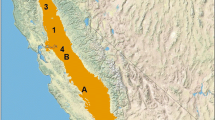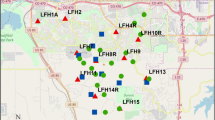Abstract
Groundwater in unconfined aquifers of limited saturated thickness can be a valuable resource but frequently it is not developed because conventional boreholes are unsuitable. However, successful exploitation of shallow unconfined aquifers has been achieved using either a line of wellpoints or horizontal wells extending for more than 100 m. The flow processes by which wellpoints and horizontal wells collect water from unconfined aquifers are explored by developing conceptual and computational models. Several representative examples are considered and it is found that similar discharges occur if the wellpoints are closely spaced. The sensitivity of the yield to physical dimensions of the wells and aquifers is explored; the impact of alternative aquifer parameters is also examined. Results from these computational models are used to identify the causes of air entry into wellpoint systems; the prevention of air entry into horizontal wells is also considered. This evaluation demonstrates that wellpoint systems and horizontal wells can efficiently abstract water from unconfined aquifers of limited saturated thickness provided that precautions are taken to prevent air entry.
Résumé
Les eaux souterraines dans les aquifères à nappe libre d'épaisseur saturée limitée peuvent être une ressource valable, mais souvent, elles ne sont pas exploitées parce que les forages conventionnels sont peu adaptés. Néanmoins, une exploitation d’aquifères libres peu profonds, a été réalisée avec succès en utilisant soit une ligne de pointes filtrantes soit des puits horizontaux se prolongeant sur plus de 100 m. Les processus d'écoulement par lesquels les pointes filtrantes et les puits horizontaux rassemblent l'eau des couches aquifères sont explorés en développant des modèles conceptuels et informatiques. Plusieurs exemples représentatifs sont considérés et on constate que des débits similaires sont obtenus si les pointes filtrantes sont étroitement espacées. La sensibilité du rendement aux dimensions physiques des puits et des couches aquifères est explorée; l'impact de paramètres alternatifs pour les aquifères est également examiné. Les résultats de ces modèles de calcul sont employés pour identifier les causes de l'entrée d'air dans les systèmes de pointes filtrantes; la prévention de l'entrée d'air dans les puits horizontaux est également considérée. Cette évaluation démontre que les systèmes de pointes filtrantes et les puits horizontaux peuvent efficacement exploiter l'eau des aquifères à nappe libre d'épaisseur saturée limitée à condition que des précautions soient prises pour éviter l'entrée d'air.
Resumen
El agua subterránea en acuíferos no confinados de limitado espesor saturado puede ser un valioso recurso pero frecuentemente no está desarrollado debido a que los pozos convencionales no son apropiados. Sin embargo, se ha logrado una explotación exitosa de acuíferos someros no confinados utilizando líneas de wellpoints o pozos horizontales extendidas por más de 100 m. Se exploran los procesos de flujo por los cuales los wellpoints y los pozos horizontales recolectan el agua de los acuíferos no confinados mediante el desarrollo de modelos conceptuales y computacionales. Se consideran varios ejemplos representativos y se encuentra que se verifican descargas similares si los wellpoints están estrechamente espaciados. Se explora la sensibilidad del rendimiento en relación con las dimensiones físicas de los pozos y acuíferos; asimismo también se examinó el impacto de los parámetros alternativos del acuífero. Los resultados de estos modelos computacionales se utilizan para identificar las causas de la entrada de aire en los sistemas de wellpoint; asimismo como prevenir la entrada de aire en los pozos horizontales. Esta evaluación demuestra que los sistemas wellpoint y los pozos horizontales pueden extraer agua eficientemente de acuíferos no confinados de limitado espesor saturado siempre y cuando que se tomen las precauciones necesarias para evitar la entrada de aire.
摘要
饱和厚度有限的非承压含水层地下水可以是非常宝贵的资源,但由于常规的钻孔在此含水层不适合,因此常常没有被开发。然而,利用一条线井点或100多米长的水平井可以成功开采浅层非承压含水层。通过构建概念和计算模型探索了井点及水平井从非承压含水层收集水的水流过程。研究了几个具有代表性的例子,发现如果井点密集类似的排泄就会出现。探索了出水量对于水井和含水层的敏感性。还调查了选择性含水层参数的影响。这些计算模型的结果用来确认空气进入井点系统的原因。还调查了怎样阻止空气进入水平井。这个评估结果显示,如果能采取预防措施阻止空气进入,井点系统和水平井可以有效地从饱和厚度有限的非承压含水层抽取地下水。
Resumo
As águas subterrâneas em aquíferos livres de limitada espessura de zona saturada podem ser um recurso valioso, porém isso não é frequentemente explotado devido a incompatibilidade com poços convencionais. Entretanto, a explotação bem sucedida de aquíferos livres rasos tem sido alcançada tanto com a utilização de ponteiras filtrantes instaladas em série como também com o uso de poços horizontais com extensão superior a 100 m. Os processos de fluxo pelo qual as ponteiras filtrantes e os poços horizontais captam a água de aquíferos livres são explorados através do desenvolvimento de modelos conceituais e modelos computacionais. Diversos exemplos representativos são considerados e descobriu-se que descargas semelhantes ocorrem se as ponteiras filtrantes forem dispostas com curto espaçamento. A sensibilidade da produção com relação às dimensões físicas dos poços e dos aquíferos é explorada e o impacto de outros parâmetros do aquífero também é examinado. Os resultados desses modelos computacionais são utilizados na identificação das causas da entrada de ar nas ponteiras filtrantes. A prevenção da entrada de ar nos poços horizontais também é considerada. Está avaliação demonstra que as ponteiras filtrantes e os poços horizontais podem extrair de maneira eficiente a água de aquíferos livres de limitada espessura de zona saturada, contanto que medidas de precaução sejam tomadas a fim de prevenir a entrada de ar.












Similar content being viewed by others
References
Barry B, Kortatsi B, Forkuor G, Gumma MK, Namara R, Rebelo L-M, van den Berg J, Laube W (2010) Shallow groundwater in the Atankwidi catchment of the white Volta Basin: current status and future sustainability. IWMI Research Report 139, International Water Management Institute, Colombo, Sri Lanka, 30 pp. doi:10.5337/2010.234
Bliss JC, Rushton KR (1984) The reliability of packer tests for estimating the hydraulic conductivity of aquifers. Q J Eng Geol 17:81–91
Brassington FC, Preene M (2003) The design, construction and testing of a horizontal wellpoint in a dune sands aquifer as a water source. Q J Eng Geol Hydrogeol 36:355–366
Cashman PM, Preene M (2013) Groundwater lowering in construction: a practical guide to dewatering, 2nd edn. CRC, Boca Raton, FL
Central Ground Water Board (2004) Kerala region: occurrence of ground water. http://cgwb.gov.in/kr/occurrence_of_GW.htm. Accessed 26 January 2015
Chenaf D, Chapuis RP (2007) Seepage face height, water table position, and well efficiency at steady state. Ground Water 45(2):168–177
Cookey ES, Rathod KS, Rushton KR (1987) Pumping from an unconfined aquifer containing layers of different hydraulic conductivity. Hydrol Sci J 32:43–57
De Silva CS, Rushton KR (1996) Interpretation of the behaviour of agrowell systems in Sri Lanka using radial flow models. Hydrol Sci J 41:825–835
Domenico PA, Schwartz FW (1998) Physical and chemical hydrogeology, 2nd edn. Wiley, New York
Driscoll FG (1986) Groundwater and wells, 2nd edn. Johnson Filtration, St. Paul, MN
Fetter CW (2001) Applied hydrogeology, 4th edn. Prentice Hall, Englewood Cliffs, NJ
Khan S, Rushton KR (1996) Reappraisal of flow to tile drains: I. steady state response. J Hydrol 183:351–366
Limaye SD (2010) Review: groundwater development and management in the Deccan Traps (basalts) of western India. Hydrogeol J 18:543–558
Mailvaganam Y, Ramili MZ, Rushton KR, Ong BY (1993) Groundwater exploitation of a shallow coastal sand aquifer in Sarawak, Malaysia. IAHS Publ 216:451–462
McDonald MG, Harbaugh AW (1988) A modular three dimensional finite difference ground-water flow model. US Geol Surv Tech Water Resour Invest 06-A1
Moench AF (2004) Importance of vadose zone in analyses of unconfined aquifer tests. Ground Water 42(2):223–233
Price M (1996) Introducing groundwater, 2nd edn. Routledge, London
Raghunath HM (1987) Ground water, 2nd edn. Wiley, New Delhi
Roberts TOL, Preene M (1994) Groundwater problems in urban areas: range of application of construction dewatering systems. Telford, London, pp 415–423
Rushton KR (2003) Groundwater hydrology: conceptual and computational models. Wiley, Chichester, UK, 416 pp
Rushton KR (2006) Significance of a seepage face on flows to wells in unconfined aquifers. Q J Eng Geol Hydrogeol 39:323–331
Rushton KR, Booth SJ (1976) Pumping test analysis using a discrete time-discrete space numerical method. J Hydrol 28:13–27
Rushton KR, Brassington FC (2013a) Hydraulic behaviour and regional impact of a horizontal well in a shallow aquifer: example from the Sefton Coast, northwest England (UK). Hydrogeol J 21:1117–1128. doi:10.1007/s10040-013-0985-0
Rushton KR, Brassington FC (2013b) Significance of hydraulic head gradients within horizontal wells in unconfined aquifers of limited saturated thickness. J Hydrol 492:281–289. doi:10.1016/j.jhydrol.2013.02.020
Rushton KR, Howard KWF (1982) The unreliability of open observation boreholes in unconfined aquifer pumping tests. Ground Water 20:546–550
Rushton KR, Redshaw SC (1979) Seepage and groundwater flow. Wiley, Chichester, UK
Simpson MJ, Clement TR, Gallop TA (2003) Laboratory and numerical investigation of flow and transport near a seepage face boundary. Ground Water 41(5):690–700
Todd DK, Mays LW (2005) Groundwater hydrology, 3rd edn. Wiley, New York
Acknowledgements
The authors acknowledge the valuable discussions with Chris Whittle, Course Manager at the Royal Birkdale Golf Course.
Author information
Authors and Affiliations
Corresponding author
Rights and permissions
About this article
Cite this article
Rushton, K.R., Brassington, F.C. Pumping from unconfined aquifers of limited saturated thickness with reference to wellpoints and horizontal wells. Hydrogeol J 24, 335–348 (2016). https://doi.org/10.1007/s10040-015-1328-0
Received:
Accepted:
Published:
Issue Date:
DOI: https://doi.org/10.1007/s10040-015-1328-0




